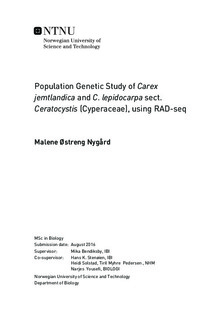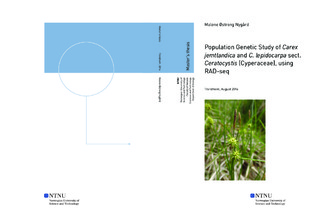| dc.description.abstract | Carex L. sect. Ceratocystis Dumort. is a small, presumably young, distinct evolutionary entity of the sedge family (Cyperaceae Juss.) known for its internally problematic taxonomy and complex morphology. For instance, there are at least four different taxonomical treatments of the two seemingly most similar species, C. jemtlandica (Palmgren) Palmgren and C. lepidocarpa Tausch. Carex jemtlandica and C. lepidocarpa have high morphological and ecological resemblance, but are geographically constrained to continental and costal areas, respectively. Therefore, these two species could represent the extremes in a continuum of intraspecific clinal variation. I sampled 156 individuals of C. jemtlandica, C. lepidocarpa, and putative hybrids from Norway and southern Sweden. Restriction site associated DNA sequencing (RAD-seq) was used to study population genetic structure in, and hybridization and introgression between, these species. Analyses of 493 SNPs indicated the presence of two distinct gene pools, largely in agreement with morphological assignment. Carex jemtlandica and C. lepidocarpa remained genetically distinct also in sympatric populations, most likely due to reduced fertility in hybrids as a result of intrinsic post-zygotic incompatibilities. The cline hypothesis can therefore be rejected. Low genetic diversity was observed within C. jemtlandica compared to C. lepidocarpa, lending support for the origin from C. lepidocarpa (or a near ancestor) as a result of founder effect or range expansion into Fennoscandia during the early postglacial period. Carex jemtlandica and C. lepidocarpa are possible taxonomical units, but a taxonomical rank was not suggested due to restricted sampling area and limited taxa included from Ceratocystis. | |

